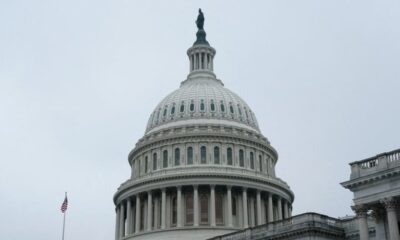Top Stories
US Navy’s DDG(X) Destroyer Faces Rising Costs and Delays

The US Navy’s next-generation destroyer, the DDG(X), is designed to enhance naval capabilities in response to the growing fleet of China’s People’s Liberation Army Navy (PLAN). Despite its strategic importance, the program faces significant challenges due to escalating costs, technological uncertainties, and production delays.
According to a report from the Congressional Research Service (CRS), the US Navy aims to procure the first DDG(X) by the early 2030s, with a research and development budget of US$133.5 million for fiscal year 2026. However, the Congressional Budget Office (CBO) estimates that each destroyer could cost a staggering $4.4 billion, which is 33% more than the Navy’s initial projection of $3.3 billion. This disparity raises concerns about the program’s financial viability.
The DDG(X) is intended to replace the aging Arleigh Burke-class destroyers and Ticonderoga-class cruisers. The new design features advanced power systems and a higher payload capacity, enabling the integration of directed-energy weapons. However, a Government Accountability Office (GAO) report from June 2025 indicated that critical technologies, including the Integrated Power System (IPS) and hull form, are still under development and may not be sufficiently tested before detailed design work begins.
Recent updates to operational requirements in August 2024, aimed at accommodating enhanced speeds and increased electrical loads, further complicate the situation. These changes have not been accompanied by revised timelines or cost estimates, prompting lawmakers to question whether the ambitious specifications of the DDG(X) justify its escalating costs.
The DDG(X) program represents a significant effort by the US Navy to develop a technologically advanced destroyer capable of countering the growing capabilities of the PLAN. Yet, significant challenges remain, particularly regarding technology readiness and industrial capacity, which could delay deployment.
Tactically, the DDG(X) will be equipped with the AN/SPY-6 active electronically scanned array (AESA) radar, which is reported to be 30 times more powerful than the existing AN/SPY-1 radar. This state-of-the-art radar system can track over 30 times the number of targets, enabling simultaneous ballistic missile defense, air defense, and surface warfare.
Additionally, the destroyer’s combat suite is expected to include two 21-cell Rolling Airframe Missile (RAM) launchers and 32 MK 41 vertical launch system (VLS) cells, with potential upgrades that include powerful lasers and hypersonic weapon capabilities. In a January 2024 article, James Black noted that shipboard lasers could provide precision strike capabilities at lower costs, with a single shot costing around $13 compared to traditional missile interceptors.
While the IPS technology is still being developed, the concept of using nuclear propulsion for destroyers may resurface, as the US Navy previously operated nuclear-powered ships during the Cold War. In a July 2025 article, Jordan Spector argued that reviving nuclear propulsion would offer advantages in power and endurance, essential for sustained combat operations. However, challenges related to port access, infrastructure costs, and a limited number of nuclear-certified shipyards could hinder this approach.
The urgency for a large surface combatant like the DDG(X) has been underscored by the rapid expansion of China’s naval capabilities. The US Department of Defense‘s 2024 China Military Power Report (CMPR) highlights that as of 2023, the PLAN has increased its fleet of large surface combatants, including at least eight Renhai-class (Type 055) cruisers, which are equipped with advanced weaponry and technologies.
As tensions with China escalate, experts emphasize that the DDG(X) program is crucial for maintaining US naval dominance. Brent Sadler pointed out that with only two US shipyards producing large surface combatants, timely investment is essential to address production delays. He advocates for an acquisition model similar to the Virginia-class Integrated Product Team (IPT), which has proven effective in managing constraints during design and fabrication.
The future of the DDG(X) program may ultimately determine whether it serves as a defensive asset for the US Navy or becomes a costly endeavor that fails to deliver on its promises. Decisions made in the coming months will be critical, as the program’s success hinges on effective management of technological risks and financial commitments before the first keel is laid.
-

 Business5 months ago
Business5 months agoKenvue Dismisses CEO Thibaut Mongon as Strategic Review Advances
-

 Lifestyle4 months ago
Lifestyle4 months agoHumanism Camp Engages 250 Youths in Summer Fest 2025
-

 Sports4 months ago
Sports4 months agoDe Minaur Triumphs at Washington Open After Thrilling Comeback
-

 Sports5 months ago
Sports5 months agoTupou and Daugunu Join First Nations Squad for Lions Clash
-

 Top Stories5 months ago
Top Stories5 months agoColombian Senator Miguel Uribe Shows Signs of Recovery After Attack
-

 World5 months ago
World5 months agoASEAN Gears Up for Historic Joint Meeting of Foreign and Economic Ministers
-

 Health4 months ago
Health4 months agoNew Study Challenges Assumptions About Aging and Inflammation
-

 Business5 months ago
Business5 months agoOil Prices Surge Following New EU Sanctions on Russia
-

 Entertainment4 months ago
Entertainment4 months agoDetaşe-Sabah Violin Ensemble Captivates at Gabala Music Festival
-

 Entertainment4 months ago
Entertainment4 months agoBaku Metro Extends Hours for Justin Timberlake Concert
-

 Top Stories5 months ago
Top Stories5 months agoRethinking Singapore’s F&B Regulations Amid Business Closures
-

 Business5 months ago
Business5 months agoU.S. House Approves Stablecoin Bill, Sends to Trump for Signature









